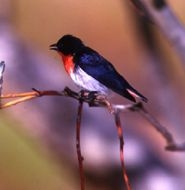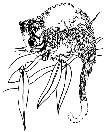
Friends of the Aranda Bushland Inc
Frost Hollow to Forest Education Kit
phone– 6251–1345, fax 6251 7621,email mefalconer@home.netspeed.com.au

Muse on the Mistletoes
About halfway along the Frost Hollow to Forest Walk, just across the fence and the fire trail at the top of the rural lease, at one edge of the Aranda Bushland, can you see the many eucalypts that have been colonised by the semi-parasitic plant, the Mistletoe (Amyema miquelii) The understorey growth includes the root parasite Cherry Ballart (Exocarpos cupressiformis), which is sometimes called the ‘mistletoe of the soil’.
Background information: Amyema miquelii (of the family Loranthaceae)
Mistletoe seeds
are usually deposited on eucalypt branches by Mistletoe Birds (Dicaeum hirundinaceum),
and less commonly by Honeyeaters (Anthochaera, Phylidonyris, Lichmera and
Acanthorhynchus) and
Silver Eyes (Zosterops lateralis)).
 Miseltoe Bird. PHOTO:
Adam Creed - Dept of Environment ©
Miseltoe Bird. PHOTO:
Adam Creed - Dept of Environment ©
A web site showing the mistletoe bird
http://lamington.nrsm.uq.edu.au/Documents/Birds/mistletoebird.htm
The black, red and white mistletoe birds feed almost exclusively on the mistletoe berries that tend to stay attached to the mistletoe for long periods. The digested and deposited mistletoe seeds secrete enzymes that eat holes in the bark of branches. The germinating seed then sends a tendril into this hole. This eventually forms a knobby haustorium (where the mistletoe root and the tree are joined). Once the mistletoe has established its roots inside the branch, it draws up water and minerals that would otherwise have fed that branch. Mistletoes also supplement these with nutrients produced by their own leaf photosynthesis. Established mistletoe tends to grow quickly unless it is killed by fire or eaten by predators. If more than 50% of the crown is infested, the tree is in trouble. Mistletoe is most commonly found on E. melliodora (Yellow Box) and E. polyanthemos (Apple Box).

Questions for discussion: Why do you think the mistletoe is so well established at this point in the Frost Hollow to Forest Walk? Notice that the infested trees are close to previously cleared paddocks and a road, and at the margin of the forest. Cherry Ballart is also prevalent. Are there many scats in the area indicating that possums and gliders are abundant in the area? Might foxes, cats and dogs have reduced possum and glider numbers or perhaps they didn’t recover from possum skin hunting long ago?
If you were a ranger for this area, what (if anything) might you do to keep the mistletoe in check? What about putting up nesting boxes to help attract possums and gliders back into the area? Or should the area be subject to a controlled burn? Or should the mistletoe be cut from the trees? What might be the consequences of these control measures?
[NB. Nothing can be done to damage flora or fauna in this area except with the authority of Environment ACT as the Aranda Bushland is part of Canberra Nature Park].
Cherry Ballart Exocarpus cupressiformis
The Cherry Ballart (also known as the Native or Brush Cherry) is common in the Aranda bushland. It has yellow-green foliage. Cupressiformis means ‘Cypress-like’. Cherry Ballart (family Santalaceae) is a root parasite, i.e. its roots attach themselves to the roots of other plants and obtain nutrients from them, whilst also obtaining nutrients through its own photosynthesis. Its red, pear shaped ‘fruit’ (on swollen sweet stems) tends to be about 1cm in size, with the seed growing outside and below the fruit.
Questions for discussion: Have a look at the cherry ballarts in this area. Do they seem to be impacting on their hosts? Do you think cherry ballarts and mistletoe might deliver a ‘double whammy’ to a tree and cause it intolerable stress? Can you see any examples of this?
Other activities:
Draw an outline of the web of life of the mistletoe on a large sheet of paper. If you delete one of the species in that web, how might than impact on the other species?
or
Find images on the Internet of the species that are interconnected in the mistletoe web of life in South-eastern Australia and make a poster showing their interaction.
References:
Anon. Case Study 2; Mistletoe, Mistletoebirds, Butterflies and Ants, <http://www.aaee.org.au/docs/cs2.pdf>, accessed 27 March 2005.
Thomas A. 2004. ‘Misunderstood mistletoe’, Scribbly Gum, March, <http://www.abc.net.au/science/scribblygum/march2004/default.htm> accessed 27 March 2005.
Grund, R. 2002. ‘South Australian
Butterflies Data Sheet: Mistletoe’,
< http://users.chariot.net.au/~rbg/mistletoe_ds.htm>
accessed 24 March 2005.
Gill, Malcolm A. 1994. ‘How Fires Affect Biodiversity’, <http://www.anbg.gov.au/fire_ecology/fire-and-biodiversity.html> accessed 27 March 2005.
Moss, H. n.d. ‘Marvellous mistletoe’ < http://home.vicnet.net.au/~croycons/docstory2.pdf?> accessed 27 March 2005.